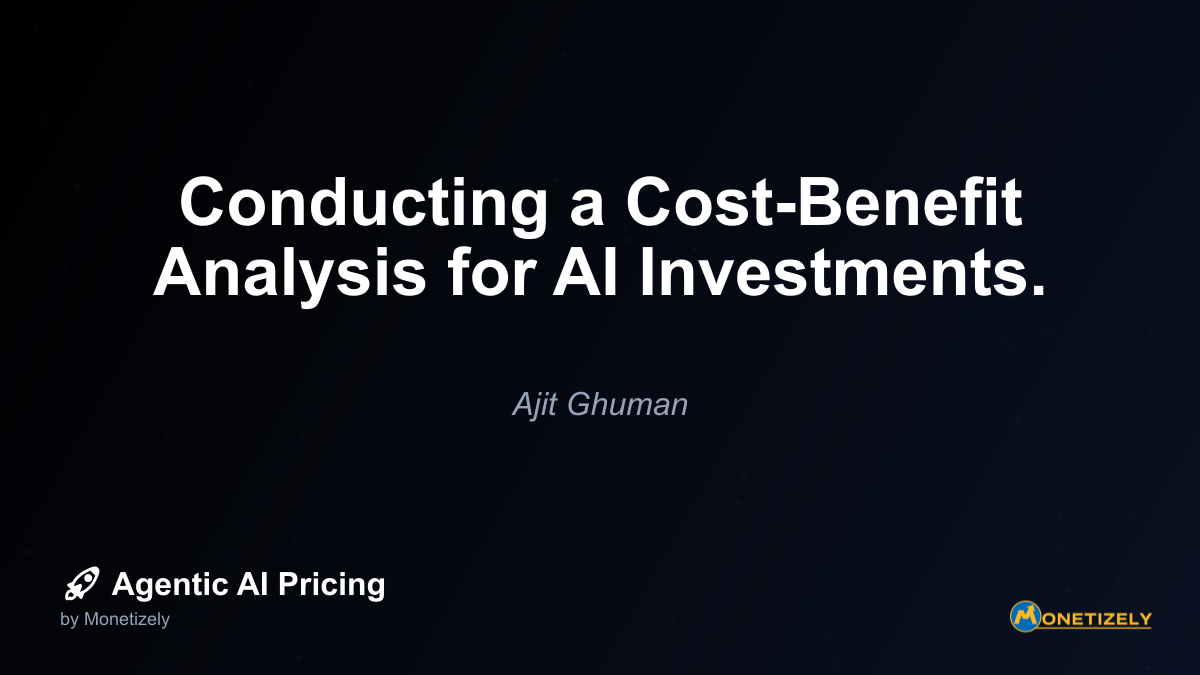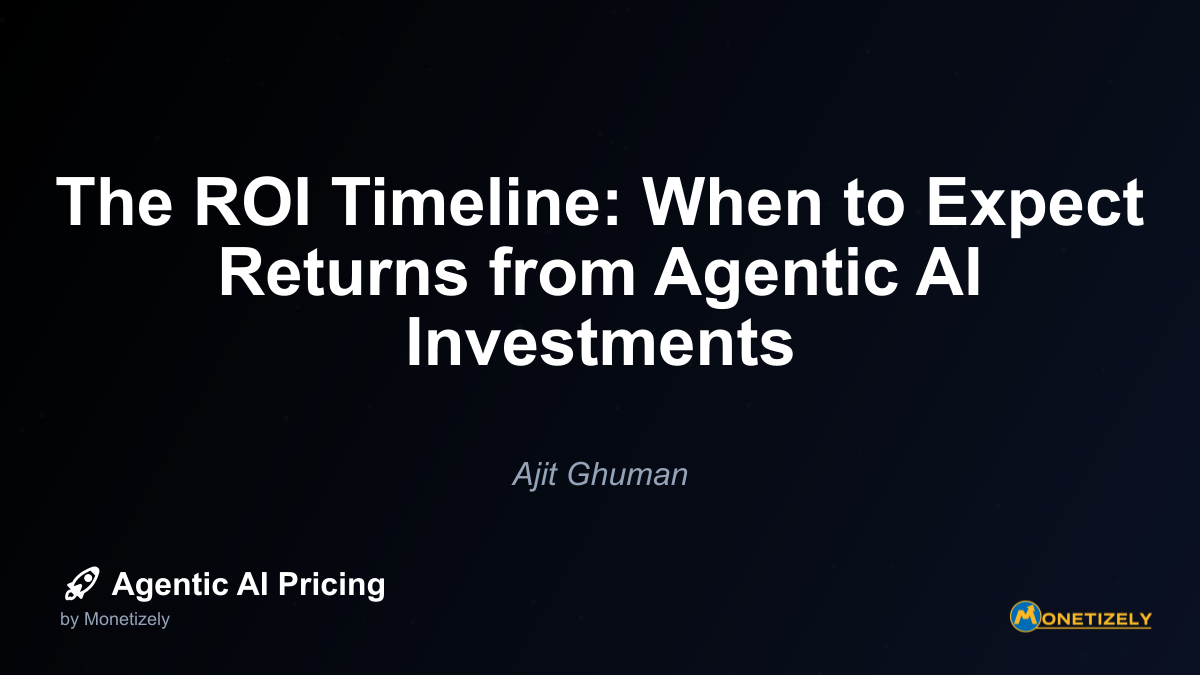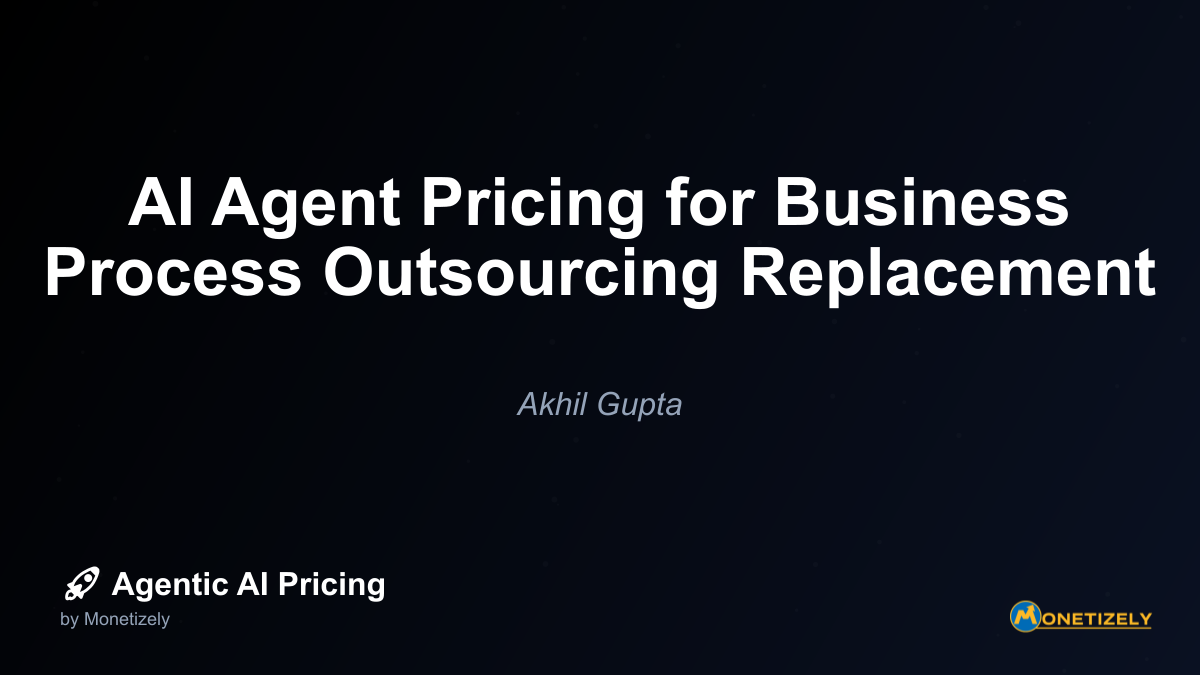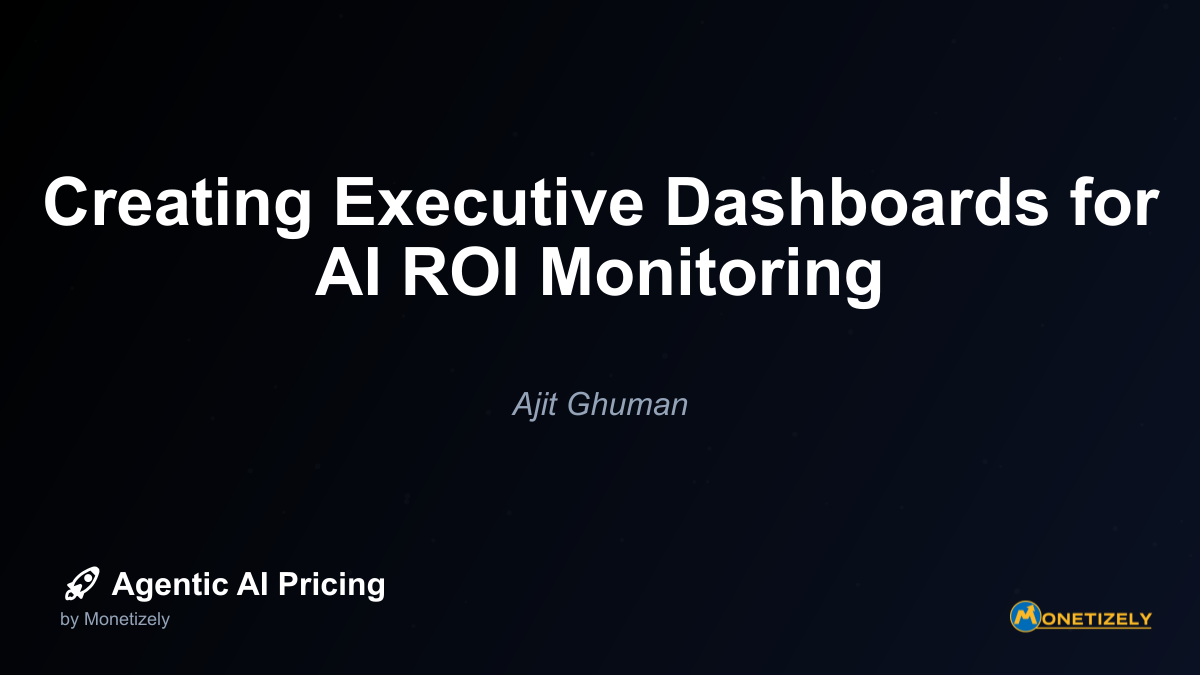· Ajit Ghuman · ROI and Value · 10 min read
Building a Business Case for Agentic AI.
AI and SaaS Pricing Masterclass
Learn the art of strategic pricing directly from industry experts. Our comprehensive course provides frameworks and methodologies for optimizing your pricing strategy in the evolving AI landscape. Earn a professional certification that can be imported directly to your LinkedIn profile.
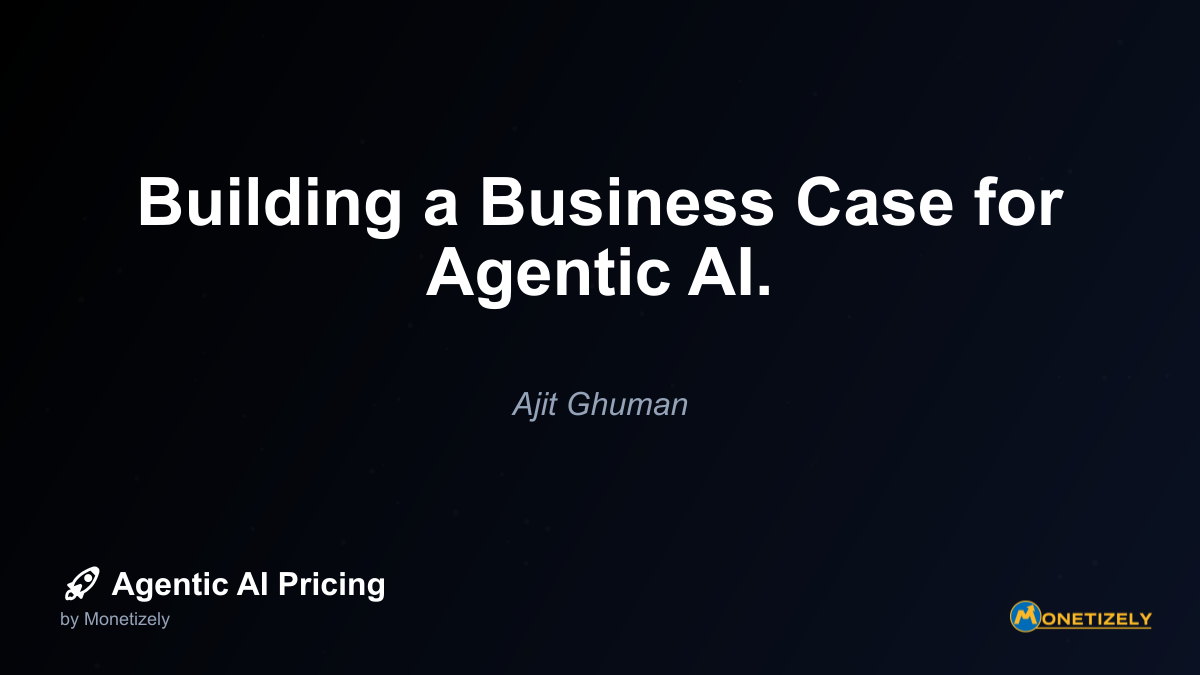
Building a compelling business case for agentic AI requires more than technical knowledge—it demands a strategic approach that speaks directly to organizational value. As autonomous AI systems capable of performing complex tasks with minimal human intervention continue to evolve, executives face critical decisions about where and how to invest. A well-crafted business case bridges the gap between AI’s technical promise and tangible business outcomes.
Why Traditional Business Cases Fall Short for Agentic AI
Traditional business case frameworks often struggle to capture the full potential of agentic AI investments. Unlike conventional technology implementations with predictable outcomes, agentic AI offers transformative capabilities that can reshape entire business models and create entirely new value streams.
The challenge lies in quantifying benefits that may be difficult to predict. Agentic AI systems can discover novel solutions to problems, optimize processes beyond human capacity, and adapt to changing conditions without reprogramming. These emergent properties make standard ROI calculations insufficient.
A more comprehensive approach is needed—one that balances immediate financial returns with strategic positioning and future adaptability. This requires a business case methodology specifically designed for the unique characteristics of agentic AI.
The Essential Components of an Agentic AI Business Case
A compelling business case for agentic AI investment must include several critical elements:
- Problem articulation - Clear definition of the business challenge
- Solution architecture - How agentic AI specifically addresses the problem
- Value proposition - Quantitative and qualitative benefits
- Cost structure - Implementation and ongoing operational expenses
- Risk assessment - Potential challenges and mitigation strategies
- Implementation roadmap - Timeline and key milestones
- Success metrics - How outcomes will be measured
Let’s explore each component in detail to build a comprehensive framework.
Articulating the Problem: Beyond Efficiency Gains
The foundation of any business case is a clearly defined problem statement. For agentic AI, effective problem articulation goes beyond identifying inefficiencies to recognize opportunities for transformation.
Start by documenting current pain points with specific metrics:
- Process completion times
- Error rates and quality issues
- Resource utilization
- Customer satisfaction scores
- Market responsiveness
- Decision-making bottlenecks
However, the most compelling problem statements for agentic AI look beyond immediate operational challenges to identify strategic opportunities:
- How might autonomous systems create entirely new customer experiences?
- Where could AI agents discover patterns humans have missed?
- What complex decisions could benefit from AI augmentation?
- Which workflows suffer from information overload?
For example, rather than stating “Our customer service response time averages 24 hours,” a stronger problem statement might be: “Our inability to provide 24/7 personalized customer support across multiple channels is limiting customer satisfaction and preventing expansion into new markets where real-time support is expected.”
This framing connects the problem to strategic business objectives and positions agentic AI as a transformative solution rather than an incremental improvement.
Designing the Solution: Capabilities and Architecture
Once the problem is clearly articulated, the business case must explain how agentic AI specifically addresses it. This section should bridge technical capabilities with business outcomes.
Key elements to include:
Agent Capabilities
Detail the specific functions your AI agents will perform:
- Information retrieval and synthesis
- Decision-making within defined parameters
- Process execution and workflow management
- Continuous learning and adaptation
- Multi-agent collaboration
Technical Architecture
Provide a high-level overview of the implementation approach:
- Required infrastructure (cloud, on-premises, hybrid)
- Integration points with existing systems
- Data sources and knowledge bases
- Monitoring and governance frameworks
- Human oversight mechanisms
Differentiation from Alternatives
Explain why agentic AI is superior to alternative solutions:
- Why traditional automation is insufficient
- Limitations of rule-based systems
- Benefits over human-only approaches
- Advantages compared to less sophisticated AI implementations
For instance, if proposing an agentic AI solution for financial fraud detection, explain how agents can autonomously investigate suspicious patterns, adapt to new fraud techniques without reprogramming, and coordinate across multiple transaction systems—capabilities that rule-based systems lack.
This section should convince stakeholders that agentic AI offers unique capabilities directly aligned with the identified problem.
Quantifying the Value Proposition
The most critical—and challenging—aspect of an agentic AI business case is articulating expected benefits in terms that resonate with decision-makers. This requires both quantitative estimates and qualitative value descriptions.
Direct Financial Benefits
Start with the most straightforward financial metrics:
Cost reduction: Calculate labor savings, error reduction costs, and operational efficiencies. For example: “Automating contract review will reduce legal costs by approximately $450,000 annually based on current outsourcing expenses.”
Revenue enhancement: Estimate increased sales from improved customer experiences, faster time-to-market, or new product capabilities. For example: “AI-powered personalization is projected to increase conversion rates by 15%, generating an additional $2.3M in annual revenue.”
Asset utilization: Quantify improved use of existing resources. For example: “Predictive maintenance agents will increase manufacturing equipment uptime by 12%, equivalent to adding $1.8M in production capacity without capital investment.”
Strategic Value
Beyond immediate financial returns, articulate strategic advantages:
- Competitive differentiation: How will agentic AI create sustainable competitive advantages?
- Market positioning: Will the technology enable entry into new markets?
- Organizational capabilities: How does the investment build future-ready capabilities?
- Scalability: How will agentic AI allow for growth without proportional cost increases?
Risk Reduction
Quantify risk mitigation benefits:
- Compliance improvements: Reduced regulatory penalties or audit costs
- Quality enhancements: Fewer defects, recalls, or customer complaints
- Business continuity: Improved resilience against disruptions
Time-to-Value Acceleration
Highlight how agentic AI can compress timelines:
- Faster insights: Reduced time for data analysis and decision-making
- Quicker execution: Accelerated process completion
- Rapid adaptation: Faster response to market changes
Scenario Analysis
Develop multiple outcome scenarios to demonstrate potential value ranges:
- Conservative case: Minimum expected benefits with high confidence
- Expected case: Most likely outcomes based on available data
- Optimistic case: Potential upside if conditions are favorable
This approach acknowledges uncertainty while providing a framework for understanding potential returns.
Understanding the Full Cost Structure
A credible business case presents a comprehensive view of both implementation and ongoing costs. For agentic AI, several unique cost categories must be considered:
Initial Implementation Costs
- Technology acquisition: Licensing, subscription, or development costs
- Infrastructure: Cloud resources, computing power, storage
- Integration: Connecting to existing systems and data sources
- Customization: Adapting models to specific business contexts
- Training data: Acquiring, cleaning, and structuring training datasets
Ongoing Operational Expenses
- Subscription/licensing: Recurring technology costs
- Computing resources: Processing power and storage for operation
- Maintenance: Regular updates and improvements
- Monitoring: Oversight and performance tracking
- Human supervision: Staff required for review and intervention
Human Capital Investments
- Skills development: Training for staff working alongside AI systems
- Change management: Supporting organizational adaptation
- New roles: Positions created to manage and enhance AI capabilities
Governance and Compliance
- Security measures: Protecting against vulnerabilities
- Compliance frameworks: Ensuring regulatory adherence
- Ethical oversight: Monitoring for bias and fairness
For each cost category, provide:
- Initial estimates
- Expected changes over time
- Comparison to status quo costs
- Assumptions underlying calculations
For example: “While initial implementation costs are estimated at $750,000, annual operational expenses will decrease by approximately 20% after the first year as efficiency improvements are realized. This compares favorably to the $500,000 annual cost of maintaining our current manual process.”
Risk Assessment and Mitigation Strategies
A thorough business case acknowledges potential risks and outlines strategies to address them. For agentic AI implementations, several risk categories deserve special attention:
Technical Risks
- Performance uncertainty: The system may not achieve expected capabilities
- Integration challenges: Difficulties connecting with existing infrastructure
- Scalability issues: Problems handling increased workloads
- Technical debt: Legacy systems may constrain AI functionality
Organizational Risks
- Adoption resistance: Employee reluctance to work with AI systems
- Skill gaps: Insufficient expertise to implement or maintain the solution
- Process disruption: Temporary productivity losses during transition
- Dependency concerns: Over-reliance on specific vendors or technologies
Business Risks
- ROI uncertainty: Benefits may materialize more slowly than anticipated
- Competitive responses: Market reactions that diminish competitive advantage
- Changing requirements: Evolving business needs that affect implementation
- Resource competition: Other initiatives may divert attention and funding
Ethical and Regulatory Risks
- Compliance challenges: Emerging regulations affecting AI deployment
- Bias and fairness issues: Potential discriminatory outcomes
- Transparency concerns: Difficulty explaining agent decisions
- Privacy implications: Data usage that raises customer or regulatory concerns
For each identified risk:
- Assess impact and probability: Rate the potential severity and likelihood
- Develop mitigation strategies: Specific approaches to reduce or manage risk
- Establish contingency plans: Actions to take if risks materialize
- Assign ownership: Determine who is responsible for monitoring and addressing each risk
For example: “To mitigate adoption resistance, we will implement a phased rollout with a champion user group, develop comprehensive training materials, and establish a feedback mechanism to continuously improve the user experience. The change management team will track adoption metrics weekly and adjust support resources as needed.”
This structured approach demonstrates thorough planning and increases stakeholder confidence in the proposal.
Implementation Roadmap: Phased Approach
A well-defined implementation roadmap demonstrates practical thinking and helps stakeholders visualize the journey. For agentic AI, a phased approach typically works best:
Phase 1: Foundation Building (Months 1-3)
- Infrastructure setup and integration planning
- Data preparation and initial model training
- Baseline performance measurement
- Team training and capability development
- Limited proof-of-concept testing
Phase 2: Controlled Implementation (Months 4-6)
- Deployment in limited production environment
- Parallel running with existing processes
- Performance monitoring and refinement
- User feedback collection and incorporation
- Governance framework implementation
Phase 3: Scaled Deployment (Months 7-12)
- Full production rollout
- Retirement of redundant systems
- Advanced feature implementation
- Optimization based on performance data
- Training for broader user base
Phase 4: Evolution and Enhancement (Ongoing)
- Continuous improvement cycles
- Capability expansion
- Integration with additional systems
- Advanced analytics on performance
- Exploration of new use cases
For each phase, specify:
- Key milestones and deliverables
- Required resources
- Decision points
- Success criteria
- Dependencies
This phased approach manages risk by allowing for course correction while demonstrating early wins to build momentum and stakeholder confidence.
Success Metrics: Measuring What Matters
The business case should clearly define how success will be measured, with metrics directly tied to the identified problems and expected benefits.
Performance Metrics
- Accuracy rates: How precisely the system performs its functions
- Speed improvements: Time savings compared to previous approaches
- Throughput capacity: Volume of work processed
- Adaptation speed: How quickly the system learns and improves
- Error reduction: Decrease in mistakes or quality issues
Business Impact Metrics
- Cost efficiency: Measurable reduction in operational expenses
- Revenue growth: Attributable increases in sales or new business
- Customer satisfaction: Improvements in experience measures
- Employee productivity: Enhanced output per staff member
- Market share: Changes in competitive position
Strategic Metrics
- Innovation rate: New capabilities or offerings enabled
- Time-to-market: Acceleration of product/service delivery
- Organizational agility: Improved response to market changes
- Capability development: Growth in organizational AI maturity
- Competitive differentiation: Unique advantages created
For each metric, establish:
- Baseline measurements (current state)
- Target values at specific milestones
- Measurement methodologies
- Reporting cadence and responsibility
For example: “We will track customer support resolution time, currently averaging 18 hours, with a target reduction to 4 hours within six months of implementation. Weekly reports will compare AI-assisted and traditional resolution times, with customer satisfaction scores as a secondary validation metric.”
Defining clear metrics creates accountability and provides a framework for evaluating success throughout the implementation journey.
Winning Executive Approval: Communication Strategies
Even the most thorough business case requires effective communication to secure approval. Consider these strategies when presenting to decision-makers:
Tailor to Different Stakeholders
Customize emphasis based on audience priorities:
- C-Suite: Focus on strategic alignment, competitive advantage, and financial impact
- Finance: Emphasize ROI, cost structure, and risk mitigation
- Operations: Highlight process improvements, efficiency gains, and implementation practicality
- IT: Address technical feasibility, integration requirements, and security considerations
Use Compelling Visualizations
Convert complex data into accessible formats:
- ROI charts: Visual representation of costs versus benefits over time
- Process diagrams: Before/after comparisons of workflows
- Dashboards: Mock-ups of how performance will be tracked
- Implementation timelines: Visual roadmaps with key milestones
Provide Concrete Examples
Move beyond abstract concepts with tangible illustrations:
- Case studies: Similar implementations in other organizations
- Specific scenarios: Day-in-the-life descriptions of how work will change
- Prototype demonstrations: Limited working examples where possible
- Simulation results: Data from test environments or pilot programs
Address Objections Proactively
Anticipate concerns and incorporate responses:
- Risk concerns: Detail mitigation strategies and contingency plans
- ROI skepticism: Provide sensitivity analysis and conservative estimates
- Disruption fears: Outline change management and transition approaches
- Technical doubts: Include expert validations and proof points
Conclusion: From Business Case to Business Value
A well-crafted business case for agentic AI does more than secure approval—it creates alignment and sets the foundation for successful implementation. By thoroughly articulating the problem, solution, benefits, costs, risks, and implementation approach, you provide a comprehensive framework for decision-making and execution.
Remember that the business case should be a living document, revisited and refined as implementation progresses and new information emerges. Establish regular checkpoints to compare actual results against projections and adjust course as needed.
The most successful agentic AI implementations begin with business cases that balance ambition with pragmatism—recognizing transformative potential while acknowledging implementation realities. By following the framework outlined in this guide, you’ll develop a compelling case that not only wins approval but also guides the journey toward realizing tangible business value from agentic AI.
As your organization embarks on this journey, maintain focus on the problems you’re solving and the value you’re creating. Technology implementation is never the end goal—it’s the business transformation enabled by that technology that ultimately delivers sustainable competitive advantage.
Co-Founder & CEO
Ajit is the author of Price To Scale, a top book on SaaS Pricing and is the Founder of Monetizely. Ajit has led and worked in pricing and product marketing at firms like Twilio, Narvar and Medallia. His work has been featured in Forbes and VentureBeat. Ajit regularly consults with software companies from Seed stage to post-IPO on pricing strategy. Ajit is also a highly-rated co-instructor for 'The Art of SaaS Pricing and Monetization' on Maven.
Pricing Strategy Audit
Let our experts analyze your current pricing strategy and identify opportunities for improvement. Our data-driven assessment will help you unlock untapped revenue potential and optimize your AI pricing approach.

